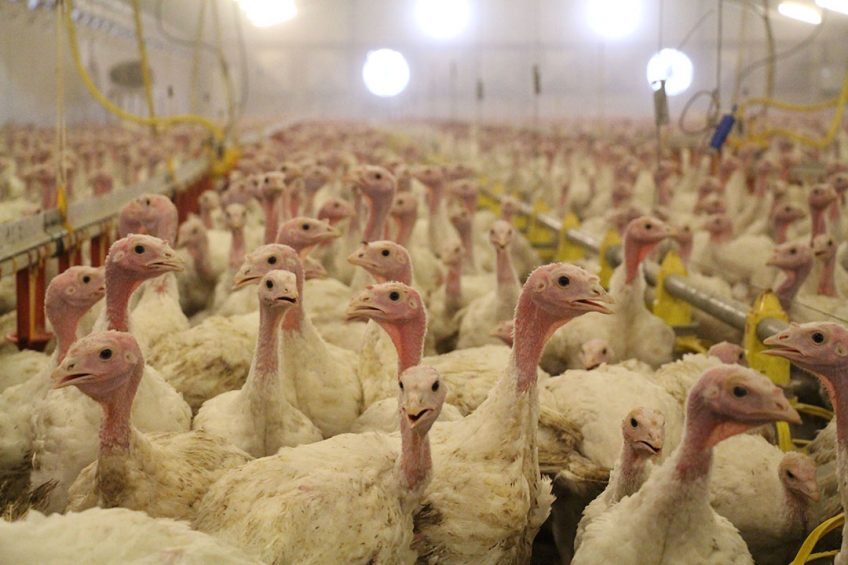Belgian turkey farmer getting the best from Europe

Overall, you could say that Belgian turkey farmer Michiel Vanoverberghe (25) benefits from Europe’s best. His turkeys go to Germany, their manure to France, Belgian regulations apply and their feed comes from the Netherlands.
At only 6 kilometres from the French border, in the beautiful Belgian landscape, lies the second location of the Vanoverberghe family’s turkey farm. Since last year, the young Belgian turkey farmer has been part of a so-called agricultural corporation. This second location is situated in Geluwe,15 kilometres from their home location in Lendelede, run by Michiel’s parents. They have 170 dairy cows there, as well as three poultry barns with 20,000 turkeys.
Vanoverberghe says, “When I was a kid, I did not want to become a turkey farmer necessarily. However, when I was sixteen years old, I went to the agricultural secondary school. I also helped my parents back then.” In 2007, Vanoverberghe’s parents were able to buy the second location in Geluwe. “A disadvantage of our home location is that it is hemmed in by a residential area,” Vanoverberghe says. “Expanding is difficult. At this location in Geluwe, houses are situated at quite a distance. Getting an environmental or building permit in Belgium is becoming increasingly difficult.”
Father Krist (50) bought the location in Geluwe in 2007 to be able to expand with turkeys. The company housed parent stock and all barns were converted for keeping fattening turkeys. This created a capacity for 24,000 turkeys.
Switching to turkeys
For years, the Vanoverberghe family had parent stock for broilers instead of turkeys at their home location, until 2016. This parent stock was kept on a feed compensation basis. Vanoverberghe adds, “The housing equipment was so outdated by 2016 that it had to be updated. A renovated barn with new equipment would cost so much that my father and I decided to completely switch to turkeys. In addition to the low investment, having the turkeys under our own management was a reason for switching.”
The prices for turkeys in Belgium were reasonable two years ago. From 2007 to 2012, turkeys were delivered to the integration Volys Star on a feed compensation base. The hens were loaded at 16 weeks and the males at 17 weeks old. New turkey chicks were reared every 18 weeks. In 2012, Volys Star indicated that Vanoverberghe’s company was too big for them to keep buying turkeys. Through Belgian contacts and Frank Rooijakkers from Dutch feed manufacturer Vitelia, sales to the German company Heidemark were realised in 2013. From that point on, the turkey chicks came from Heidemark as well, which owns both slaughterhouses and turkey hatcheries.
Vanoverberghe only breeds hens now. Turkey males slaughtered at 21 weeks, involve more risks than hens, leave the company at 16 weeks. Belgium has only one slaughterhouse and about 25 turkey farmers.

Own turkey loader
The family bought a second-hand turkey loader from a German farmer in 2016. It came from CMC Poultry, the Italian manufacturer of poultry loading equipment. Vanoverberghe: “We are very happy with it”. The turkey farmer is successful in making a profit, in part because he manages to reduce costs by mixing 10-30% wheat in the feed. He does think it is odd that there are so many broiler farmers mixing in wheat, but virtually no turkey farmers. He uses his own JCB telescopic handler to get the manure out of the turkey barns. All of it goes to France, that is only a stone’s throw away. Vanoverberghe states, “I pay about € 4 a tonne, mostly transport costs. If I did not have this, the French would even pay me for it,” he laughs.
In 2010, the family built a new turkey barn for 6,000 birds in Geluwe. The family then owned eight houses and 30,000 turkeys at this location. In 2016, the family decided to build a breeding barn for 27,000 birds that could be reared in eight weeks. This brought the total amount of birds in Geluwe to 54,000.
Producing hens is cheaper
In 2007, the male/hen ratio was 50-50%. This was the reason that the animals went to Volys Star. Now, Vanoverberghe mainly produces hens. “We do not have a system of production rights, which are required in the Netherlands. Therefore, it is smarter to produce hens in Belgium. In the Netherlands, you need poultry rights for every bird. Therefore, if you breed many males in the Netherlands, you get more kilogrammes for the same amount of rights. That is not the case in Belgium. And if you take into account that I can buy five B.U.T Big 6 turkey hen chicks here for the price of two B.U.T. Big 6 turkey male chicks, the choice is not difficult, right?”
The reason that the turkey farmer from Geluwe buys his feed from the Dutch compound feed company Vitelia is that there are only few compound feed companies in Belgium that are specialised in turkey feed. “Dutch feed companies can deliver a better quality turkey feed.”
Vanoverberghe uses wood shavings as floor covering during the chicks’ start-up phase. Because shives were actually much cheaper, this product is used in the fattening stage and for additional scattering. “Shives is a residual product of the flax production that is quite common in this part of Belgium. Flax is produced in France and partially processed in the region around Geluwe. The only disadvantage is that, just after scattering, it causes some dust to form. For the rest, it is a good and cheap product,” says Vanoverberghe.

Natural ventilation
The new fattening barn for 16,000 turkeys was completed in May of this year. In order to build the barn, two barns were demolished. This brought the total to seven barns in Geluwe, with 68,000 turkeys, including 27,000 turkeys for breeding. The new breeding barn has a special, natural ventilation system that can only be found at a select number of European turkey farmers. A two-metre butterfly valve with side hinges that open outward is suspended from both sides of the barn. The same goes for the ventilation hatches on the ridge that close or open depending on the weather. The advantage of this natural ventilation system is that a lot of air can be moved with relatively low pressure. Because of this, the air flows in steadily and sickness because of draft is not a problem.
In the new barn, in which Vanoverberghe has already done one round, the results are better than in the old barns. “Honestly, the vapour installation, manufactured by Silobouw Decock, has a lot to do with that too.”
In the old barns, the hens weighed 10,3 kilogrammes on average after 16 weeks. In the new barn, they are 10.6 kilogrammes upon delivery. During the extremely hot summer round before that, the difference between the new and old barns was 600 grammes after 16 weeks. For the turkey farmer, this meant € 0.73 per bird more that round. “During the winter, the difference between the old barns and the new one will not be that large. The advantage will probably be € 0.20 or € 0.30 per animal,” Vanoverberghe adds.

Inexpensive shives
The family has been using shives as floor cover for six years now. “Before that, we used wood shavings. Shives, coming in abundance as a residual product from factories here, was much cheaper: about € 0.04 per kilogramme less. Since I started using shives, the results are much better. This is because the birds’ soles remain cleaner. Shives absorb more moisture than wood shavings.” He also mixes in about 30% wheat into the compound feed. This saves around € 0.60 to € 0.70 per 100 kilogrammes, which is € 0.17 cents per animal. “I also calculated the difference in feed conversion between full compound feed and mixing in wheat. That resulted in € 0.50 and € 0.80 per turkey.” The feed conversion with wheat is better, just as their gut health.
|
The Belgian turkey farmer does take sustainability into account, but is not directly focussed on it. “I do not invest in solar panels; I think that is an investment for old men. I would rather invest in some extra barns that use less energy than generating only green power on a whim. In the barn, Vanoverberghe works with direct heaters from Ermaf. The feed silos are constructed by M.I.P. For the breeding part, he works with an ITB heat exchanger. The feed line is manufactured by Roxell and the water line comes from Lubbing. In the new fattening barn, the feed line comes from Chore-Time and the waterline from Lubbing, in the fattening version with a large bowl. Vanoverberghe’s plans are very clear: replacing the four old barns for new ones. “I already have the license to keep 84,000 turkeys. It took me a year to get it.”


 Profile: Michiel Vanoverberghe (25)
Profile: Michiel Vanoverberghe (25)









